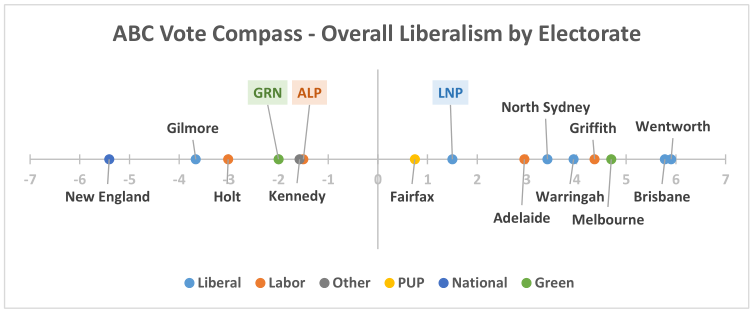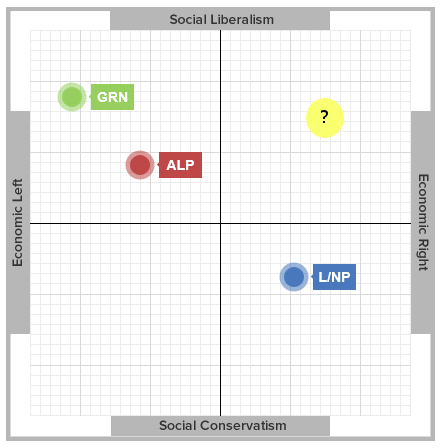The ABC Vote Compass consisted of 30 questions: 15 related to social freedom and 15 related to economic freedom. Each question had five possible answers: strongly agree/disagree, somewhat agree/disagree and neutral, with 'sometimes' given a value half as much as a 'strongly'.
Some of the summary data now is available, allowing an initial analysis, such as an overall liberalism index, showing the most control-leaning vs freedom-leaning seats, the compliment to the most left-leaning and right-leaning seats reported by the ABC.
Electorates such as Curtin (Julie Bishop), Wentworth (Malcolm Turnbull), Melbourne (Adam Bandt), Griffith (prev. Kevin Rudd) and North Sydney (Joe Hockey) are some of the most freedom-leaning seats, whilst Kennedy (Bob Katter), McMahon (Chris Bowen) and New England (Barnaby Joyce) are at the other end of the spectrum.
ABC Vote Compass
By answering the questions, you could get an (unweighted) score on each axis between -15.0 to +15.0, in 0.5 step increments (i.e. 61 possible values on either axis), which were then plotted on a graph, along with the major parties.
Here is where Vote Compass placed the major parties:
The summarised data available includes official releases of the distribution of answers for each question by various demographics, as well as the data driving several of the pages on the ABC such as the average answer for each question by electorate used in the interactive map.
With the available data it is interesting to see how various averages fit into the graph.
Electorates By Party
Here are all the electorates, placed on the graph by summing the averages for each question (based on how it would be plotted on the compass) and coloured by the current party holding the seat:
There is quite clearly a negative correlation between social liberalism and economic liberalism, which may be due to people answering 'along party lines'. As expected, Labor held seats dominate the top left, whilst the Coalition dominates the bottom right.
The Greens held seat is in the far top left, whilst the National held seats (a slightly darker blue) are generally lower on both the social liberalism and economic liberalism scales than other Coalition seats.
The most freedom-leaning seats
We can also show the detail of the specific electorates that fall into the top right quadrant, those with the most freedom-leaning averages, that support both social liberalism and economic liberalism:
Note that the average location of an electorate doesn't necessarily mean that there are actual people who would fall on that spot in the graph, as it is only an average, and could simply reflect a mixed electorate of both Labor and Coalition voters, where the average just happens to fall in that quadrant.
Overall liberalism (or overall freedom)
As mentioned in the introduction, the ABC presented one analysis on the most left- and right-leaning seats, effectively plotting all electorates on a diagonal running from the top left (controlled economy, social liberalism) to the bottom right (economic freedom, social conservative).
It is also possible to rank electorates based on their overall liberalism (or overall freedom) index, the other diagonal running from the bottom left to the top right. A summary of the overall liberalism of a selection of electorates and the major parties is give in the introduction.
From calculating the rating of the major parties (based on their position on the graph), and can see in the introduction that the Coalition (LNP) has the highest freedom index (it is closest to the top right), winning on the strength of its economic platform, whilst the Greens, despite supporting social freedoms have a lot more restrictive economics (economic left).
The index reflects to what degree is a position on the compass holds to both social freedoms (social liberalism, that is tolerance or race, sexuality and new ideas), and economic freedom (free markets, free trade -- the economic right).
Overall liberalism for an individual will range from -30.0 to +30.0, although given the negative correlation along party lines the averages for electorates only range from around -5.4 to +6.2, as seen in the linear chart in the introduction.
Here is the full list of electorates, ranked by control/freedom (similar to the ABC ranking left/right):
This control-/freedom- diagonal is the opposite of the left-/right- diagonal in the ABC article. For example, Brisbane and Gilmore are both in the middle of the left-/right- diagonal, but at opposite ends of the control-/freedom- diagonal.
Next steps
I'm not sure why there is a negative correlation between social liberalism and economic liberalism, in Australia, but it is clearly there in the data.
For example, why would someone who supports gay marriage also be in favour of government propping up of the car industry, or why would someone who supports reducing government expenditure necessarily be against assisted suicide?
The negative correlation between these doesn't seem to make sense, although it does exist so I suspect that some of it may reflect the influence of the major parties, with people simply answering 'along party lines'.
For a better analysis, a heat map of individual responses would be good, however this would required the raw data of individual responses (or at least individual overall position), which has not yet been released.
This would help answer questions such as whether those electorates with a high overall liberalism (overall freedom) reflect individuals with those beliefs or merely a mix -- average -- between groups of Labor and Coalition voters.
Such information would be useful for those supporting freedom-based parties such as the Liberal Democratic Party (LDP), Sex Party, Wikileaks, Pirate Party, Secular Party, etc.






2 thoughts on “Australia’s most control-leaning and freedom-leaning seats(5 min read)”